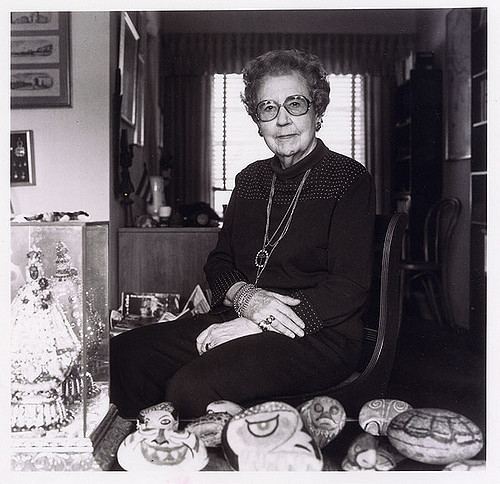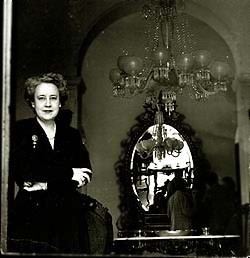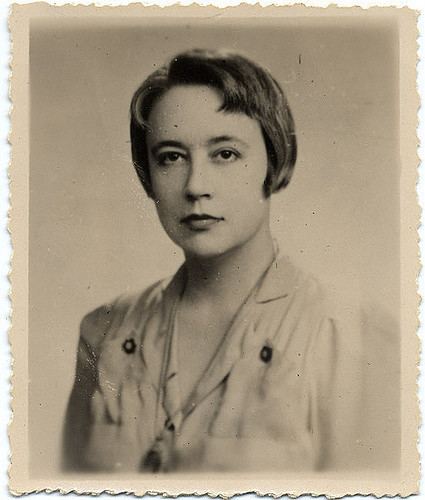Nationality Cuba Name Lydia Cabrera Known for Afro-Cuban Poetry Role Poet | Education Ecole du Louvre Fields Anthropology | |
 | ||
Died September 19, 1991, Miami, Florida, United States Books El monte, Cuentos negros de Cuba, Afro‑Cuban tales =, La Regla Kimbisa del Santo, Anaforuana | ||
Influenced Afrocubanismo Movement | ||
Mariela a gutierrez lydia cabrera la autora y la afrocubania de su universo narrativo
Lydia Cabrera (May 20, 1899 in Havana, Cuba – September 19, 1991 in Miami, Florida) was a Cuban anthropologist and poet.
Contents
- Mariela a gutierrez lydia cabrera la autora y la afrocubania de su universo narrativo
- Lydia Cabrera Ya te Vi
- Early life and education
- Involvement in Afrocubanismo and the preservation of Afro Cuban culture
- Main work themes
- Coming to the United States
- References

Cabrera was a Cuban writer and literary activist. She was an authority on Santería and other Afro-Cuban religions. During her lifetime she published over one hundred books; little if any of her work is available in English. Her most important book is El Monte (Spanish: "The Wilderness"), which was the first major anthropological study of Afro-Cuban traditions. Published in 1954, the book became a "bible" for Santeros who practice Santeria, a blend of Catholic teachings and native African religions that evolved among former African slaves in the Caribbean. She donated her research collection to the library of the University of Miami. A section in Guillermo Cabrera Infante's book Tres Tigres Tristes is written under Lydia Cabrera's name, in a comical rendition of her literary voice. She was one of the first writers to recognize and make public the richness of Afro-Cuban culture. She made valuable contributions in the areas of literature, anthropology, and ethnology.

In El Monte, Cabrera fully described the major Afro-Cuban religions: the Regla de Ocha (commonly known as Santeria) and the Ifa’ cult, which are both derived from traditional Yoruba religion; and Palo Monte, which originated in Central Africa. Both the literary and anthropological perspectives on Cabrera’s work assume that she wrote about mainly oral, practical religions with only an “embryonic” written tradition. She is credited by literary critics for having transformed Afro-Cuban oral narratives into literature, which is, written works of art, while anthropologists rely on her accounts of oral information collected during interviews with santeros, babalaos, or paleros, and on her descriptions of religious ceremonies. There is a dialectical relationship between Afro-Cuban religious writing and Cabrera’s work; she used a religious writing tradition that has now internalized her own ethnography.
Lydia Cabrera-Ya te Vi
Early life and education
Born in Havana in 1899 as the youngest of eight siblings, she comes from a Cuban family of social and financial privilege in pre-revolutionary Cuba. Her father, Raimundo Cabrera, who was a writer, jurist, and lawyer, was a prominent man in society as well as an advocate for Cuba's independence. He was the owner and editor of the Cuban journal, Cuba y America. This news paper involved politics and her father wanted to become independent from Spain. Her mother, Elisa Marcaida Casanova, was a housewife and respected socialite. The family had many Afro-Cuban servants and child caretakers, through whom young Lydia learned about African folklore, stories,tradition,religions, and their mystical world. Her father was also the president of the first Cuban corporation, La Sociedad Económica de Amigos del País, founded in the eighteenth century. He owned a popular literary journal, Cuba y America, where Lydia got her first experience as a writer. At the age of thirteen, Cabrera wrote a weekly anonymous column that appeared in her father's journal. She covered topics relevant to her specific community, such as wedding announcements, childbirths, or obituaries.
Like the majority of wealthy Cubans in the early 1900s, private tutors came to the home of the Cabreras to educate the children. For a short period of time, she attended the private school of Maria Luisa Dolz. At that time it was not socially acceptable for a woman to pursue a high school diploma, so Cabrera finished her secondary education on her own.
By 1927 Cabrera found herself wanting to make money on her own and she wanted to become independent of her family. She moved to Paris to study art and religion at L'Ecole du Louvre She studied drawing and painting in Paris with theatrical Russian exile Alexandra Exter. Cabrera lived in Paris for 11 years and returned home in 1938. After graduating from art school, she chose not to become an artist as expected. Instead she chose to move back to Cuba to study Afro-Cuban culture, especially their traditions and folklore.Lydia Cabrera is a creative writer who writes in order to retell the history of Cuba. She worked closely with Fernando Ortiz even though she was younger than him.
Involvement in Afrocubanismo and the preservation of Afro-Cuban culture
For almost all of her life, Cabrera possessed a large interest in Afro-Cuban culture. She had been introduced to their folklore at a very young age by her Afro-Cuban nanny and Afro-Cuban seamstress. Three factors influenced her decision to study Afrocubanismo as an adult. The first influence was her experience in Europe, where studying African art became very popular. Secondly she was influenced by her studies in Paris, where she began to see the large influence that African art had on Cuban art. Thirdly she had as a companion Teresa de la Parra, a Venezuelan novelist and socialite whom she met while studying in Europe, and who enjoyed reading Cuban books with her. They often studied about the island together.
With her focus on thoroughly exploring Afro-Cuban culture, she returned to Cuba in 1930. She moved to a ranch, La Quinta San Jose, in the suburb of Havana, Marianao, located just outside the barrio Pogolotti where she conducted most her research on Afro-Cuban culture. Between 1937 and 1948, she published her second book of short stories Por Que...Cuentos negros de Cuba. For this collection, she participated in the culture of the Afro-Cubans and recorded their religious rituals and traditions.
During the late 1950s she continued to publish several books about Afro-Cuban religions, especially focusing on the Abakuás. Being a secret society, the Abakuás were reluctant to talk to her about their religion. Since they did not accept women as members, Cabrera relied on the use of interviews to gain information for her book. It focused on the origins of the group, the myth of Sikaneke, and the hierarchy of its members. Somehow she managed to photograph their sacred drum, which is supposed to remain hidden at all times, to include within her research.
Main work themes
Her career spanned decades before the Revolution, as well as many years after the revolution in Cuba. Although she was never schooled in anthropology, she takes a very anthropological approach to studying her subject matter. The main theme in her work is the focus on to the once-marginalized Afro-Cubans, giving them a respectable identity. Through the use of imagery and storytelling in her work, she seeks to retell the history of the Cuban people through the Afro-Cuban lens. Generally, her work blurs the line between what society has deemed as "fact" and "fiction." She attempts to pose ideas and theories that force one to question what they have been told.In Afro-Cuban Tales = Cuentos Negros De Cuba, She writes, "They dance when they're born, they dance when they die, they dance for killings. They celebrate everything!" (Cabrera 67). Here, she is connecting Afro-Cuban tales with African rituals because it is important to celebrate birth, passage to adulthood, marriage, and death.
Coming to the United States
She left the country in 1960 shortly after the revolution and never returned. She left as an exile, first going to Madrid and later settling in Miami, FL., where she remained the rest of her life. Ms. Cabrera received several honorary doctorate degrees, including one from the University of Miami in 1987. Cabrera describes her stories as "transpositions," but they went much further than a simple retelling. She recreated and altered elements, characters, and themes of African and universal folklore, but she also modified the traditional stories by adding details of Cuban customs of the 19th and early 20th centuries.
Toward the last years of her life, Lydia Cabrera worked diligently to edit and publish the many notes she had collected during more than thirty years of research in Cuba.
The real reason why she left is still unknown. Some claim that she left because of the lifestyle the revolution was trying to instill. For many years, Cabrera had stated her dislike for the revolution and socialist-Marxist ideology. Others claim she left because members of the Abakuás were hunting her down since she had made their secret society public. Although the reason why she left is unknown, she never returned and spent the rest of her life living in Miami until her death in September 19, 1991.
